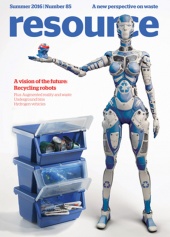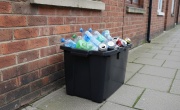Product design for the circular economy
Have you ever had a laptop (or indeed another electronic product) that works perfectly apart from that one bit somewhere inside that renders the whole thing useless, that is so hard to get at that it’s cheaper and easier to get a new one than find a fix? The smart money’s on ‘yes’, and I don’t even need to ask whether you have taken your lunch out of its packaging, only to realise that the wrapping is made up of two noncompatible materials that consign it to the bin.
Neither of these issues necessarily requires grand technological or scientific advances to rectify, but both of them were destined to happen the moment the product passed the design stage. The oft-repeated tenet, which originally appeared in a 2002 Design Council study, is that 80 per cent of a product’s environmental impact is determined during its design. Decisions made early in product development dictate what the product will be, what the business model is that supports it, what it will be made from, where it will be made, how much energy it will use in the lifecycle and what will likely happen at its endof-life. Once all that is decided, it’s hard to change its path later on in the process.
Back in the summer of 2013, when circularity was the buzzword of the day, Sophie Thomas, then-Director of the RSA’s Great Recovery sustainable design project, told us that a lack of communication between designers and those in the post-user, end-of-life stage was holding back efforts to use design to harness the reuse and recovery of resources. Three years later, and the circular economy has become even more embedded in any waste and resource industry discussions, but has real progress really been made on ecodesign and its implications for product waste?
Dr Katie Beverley from Cardiff’s Ecodesign Centre (EDC), a research and knowledge transfer centre whose ambition is to ‘make ecodesign happen’, comments: “We work in a number of ways with our stakeholders, offering advice to governments on policy enablers, working with educators to promote ecodesign education, and working directly with companies to transfer ecodesign and sustainable knowledge into their practices.
“There’s definitely an appetite for change – and that’s partly related to the traction that the circular economy has gained. I’m no longer approaching companies and being asked to justify why resource efficiency is important for them. Lots of companies are looking at approaches that don’t disrupt business-as-usual too much (looking to improve the recyclability of their products and introducing take-back schemes, for example).”
Collaboration is key
While that figure of 80 per cent shows the powerful effect that design can have (and Thomas says the claim has stood up to a lot of scrutiny), it doesn’t mean that the power to foster the movement into a circular economy lies solely in the hands of designers. Despite improvements, she says, these briefs rarely extend past the focus on the person who is using the product in the first place. “Imagine if we could add in a sentence to every brief that just said: ‘Design this product for second and third lives.’ You would immediately shift along the design to move from just thinking about the first user to considering how you throw it away, whether it’s recycled, how you can recover the materials and make it back into the same product, whether you can get it into reuse. All those conversations suddenly come into play.”

Indeed, a product’s design does not begin and end with one person sitting at a desk with an HB pencil. There is a whole design chain, a collaboration between a number of parties, that determines what goes into a design, starting with a brief handed down to the designer. Thomas, updating Resource on the state of play, explains: “Let’s take a toothbrush, for instance. The brief for a toothbrush would be about ergonomics, price point, colour, desirability in terms of aesthetics, price of assembly, all those different things coming into play.”
The main barrier to designing out waste, therefore, is getting everyone in the chain to appreciate the possibilities, and most importantly for those interested only in the bottom line, to harness circular business models. According to Beverley, we will really see the potential for ecodesign realised when reuse and recovery of materials are seen as integral parts of the sales process and not nice bonuses at the end of it. “I prefer not to think of designers’ roles as being ‘designing out waste’, but being ‘resource effective’, making them go as far as they can. Physical products require materials and have finite lives in the hands of a single consumer that need to be carefully managed. It’s no good employing all the world’s best resource-efficient design strategies if the product just ends in the bin.
“Companies who are looking at extended producer responsibility and product stewardship models (e.g. having a take-back scheme for products or leasing products rather than selling them) are making the level of change that’s needed for us to reach more sustainable levels of living – because, frankly, it’s a step change that’s needed from our current position.”
These product stewardship models, she suggests, would open up all sorts of design implications for reducing waste: they could be set up for longevity (leasing to multiple customers), high-intensity use (sharing for products like lawnmowers), refurbishment (for take-back models) and so on.
But in a world where some companies plan for obsolescence in their products, and indeed limit reparability, to hasten sales of the next model, is this stepchange likely to happen?
Thomas reckons so: “We’ve sleepwalked into a consumption model which basically has expanded the definition of what is disposable. Some phones are so cheap that they just don’t hold value at all and they become disposable items, yet they still have a massive eco-rucksack behind them and they’ve still been made in 10 different countries.
“But we talk about a perfect storm on the horizon where we have increased demand for materials from population increases, middle classes in the developing world increasing, geopolitical pressures put on certain resources and finite accessible resources of elements… All of those factors line up, and we’ll get to the point where one would hope that their business models have to change. We can’t carry on as we do, because you’re going to have businesses which have their profit models eaten away by all of these pressures.”
The role of education
Despite the collaborative approach to a product’s design, designers can still play a pivotal role, but need to be clued up on sustainability to do so. The ability to scrutinise, for example, between ‘greenwashing’ claims about a material’s credentials or to help a client understand alternatives requires teaching. Thomas suggests that while the role of sustainability in design education has come on in leaps and bounds, it tends to only be elaborated on in optional modules.
By and large, education in sustainable design tends to come in post-graduate courses. Dr Paul Micklethwaite, Senior Research Fellow at Kingston University, leads one such course, and says that, due to the huge range of concerns and design strategies, any teaching about sustainability in foundation design courses is often “simplistic and single-issue, covering things like the use of recycled materials”. This means that in-depth teaching on sustainability is more suited to later study, but also that many are passing through their qualifications without being taught many of the main principles of ecodesign.
Micklethwaite says that end-of-life practice is a “key topic” in sustainable design education: “Extending product lifespan is not in itself always sensible – many products are over-specified in this regard in that they long outlive their use phase. A product is simply a temporary configuration of materials for some present benefit; if that benefit disappears or is no longer apparent, we need to be able to reconfigure its materials easily for new benefit.”
Two key skills that he highlights are the ability to see through greenwashing (“the great peril with regards to sustainability… much of what passes for ‘sustainable’ is tokenistic and single-issue”) and to put sustainability into context (“what may be considered sustainable in one location may not translate well elsewhere”).
Both Thomas and Micklethwaite note an increased desire in young designers to learn about and use sustainable practices, a movement that could herald a greater focus on sustainability education in the future. Beverley also notes that “business schools are looking at design thinking and strategies for sustainable business as well as design schools”.

Policy needed to push things forward
In any case, the great driver of ecodesign will be legislation and policy. “It’s all well and good saying that business will drive us forward,” says Thomas, “but there will come to a point where they will go ‘this does not give me a competitive advantage’. You need to level out the playing field, you need to have drive and push and pull from lots of different angles.
Europe has been the main driver behind the push towards resource-efficient product design, according to Thomas, with the circular economy discussion helping to bring “real movement towards better, new relationships and new collaborative partnerships”.
The move in Europe towards a circular economy, though criticised by some for focusing too much on waste and not on the alternative routes for resources, stands to hasten improvements in some areas. The European Commission has been promising an Ecodesign Work Plan for some time now – it was originally meant to be finalised in January 2015 – but will now publish the plan in the autumn. The work plan, nominally covering 2015-17, will look at addressing energy efficiency in products as well as reparability, durability, upgradability and recyclability, with the suggestion that ‘ecodesign be extended to ending planned obsolescence’. FEAD, the federation representing the European waste management industry, has criticised the delay, stressing that ecodesign will play ‘a determinant role’ in the successful transition to a circular economy and will become a crucial step to closing product loops.
Of course, with the future working relationship between Britain and Europe completely up in the air, and with uncertainty likely to muddy our interaction with the union over the next few years, how any impending action will affect design in the UK is unknown. Thomas does assert, however, that prior to the Brexit vote the UK was “in a position where we were leading a lot of the discussions and thought” around circular design.
Indeed, ecodesign regulations are amongst those most commonly used by the media as sticks with which to beat the EU. ‘European bureaucracy’ is often blamed for hairdryers, toasters and vacuum cleaners becoming less powerful, even though, according to the EU, the average energy bill of British homes is likely to fall by more than £350 each year from 2020 because of appliance standards driven by ecodesign. Could an increased focus on materials have a similar effect?
Whatever happens with the UK’s adherence to European directives, action will need to continue in the UK. The Netherlands and Scotland are already carrying out work to push businesses in a more circular direction (the latter with the help of the EDC), so we know that national action is achievable.
Thomas explains: “We need to get people together in a room and have this precompetitive discussion about things that aren’t the edge that these companies want to give their products but more about the baseline of everybody coming at the same point where you can think about the material stream, you can think about issues that are bigger than the brands themselves.”
As luck would have it, in March Thomas was made a trustee of the Waste & Resources Action Programme (WRAP), the organisation that has established industrywide voluntary agreements on resource efficiency for clothing, food and drink and electrical goods (the latter of which has targets for product durability and schemes for reuse and waste minimisation).
It’s early days for Thomas at the organisation, but could a similar agreement be made surrounding product design? “Well, wouldn’t that be great? I’m very excited about the opportunities there, particularly the growing interest within SMEs and entrepreneurs around the circular economy… Watch this space.”
Three new well-designed products
The Do chair
 This article was taken from Issue 85
This article was taken from Issue 85Office furniture manufacturer Orangebox’s ‘Do’ chair was designed to be ergonomic and user friendly, but also sustainable. Made entirely from recyclable (and, where possible, recycled) materials, the chair was designed for disassembly, with the seat, arms and back fabric simply clipping on and off to make repair and remanufacture simpler. The number of materials was also reduced with markings designed in to identify the material type and facilitate recycling. Orangebox also worked with its supply chain, using local suppliers wherever possible and taking steps to drive its approach along the chain.
Kingfisher drill
Many power tools have components that are extremely durable and not subject to technological advances, but tend to get thrown away with the rest of the tool when more sensitive parts break. Along with Brunel University, DIY retailer Kingfisher has developed a cordless drill that can be disassembled in under a minute to keep working parts in the loop and to remove faulty parts that can be shipped back to the manufacturer to be completely recovered.
The Optimist toaster
After finding that people are reluctant to take small appliances to their local recycling centre, the Agency of Design decided to make a toaster that would never need to be disposed of. Rather than popping mechanisms that can fail, its Optimist toaster has a rotating arm with few moving parts. The base can be removed, with all components popping in and out and every component is made out of highly recyclable aluminium, starting out with 100 per cent recycled content. To celebrate the product’s longevity, it even has a ‘toastometer’ that clicks round every time a new slice is cooked.





